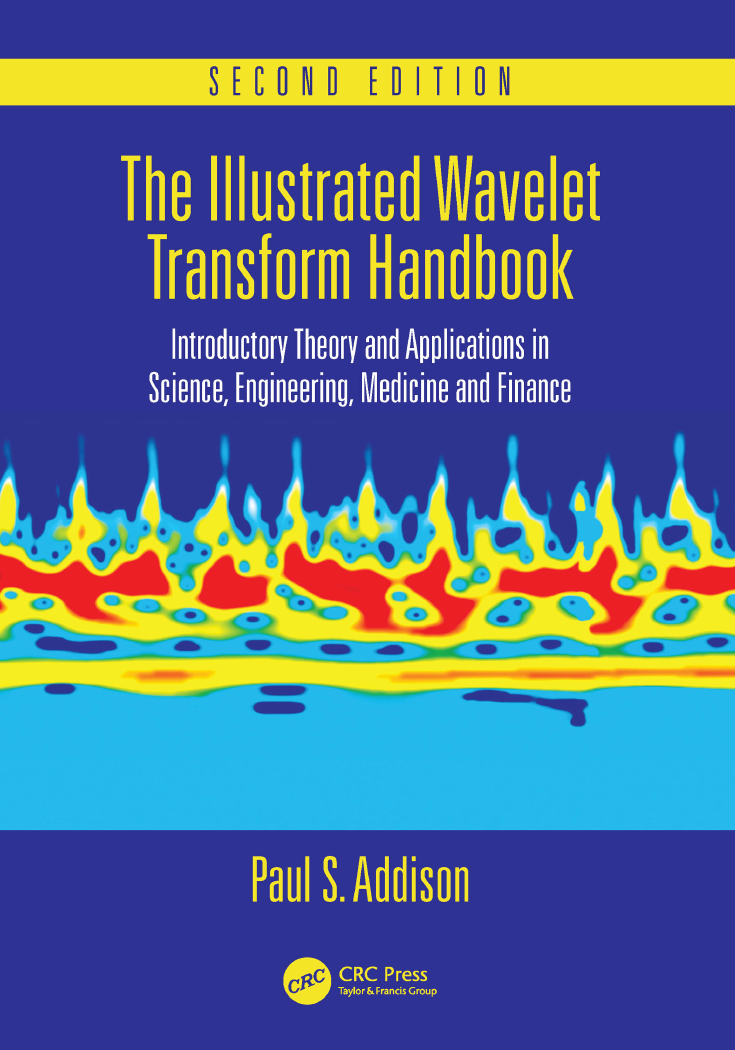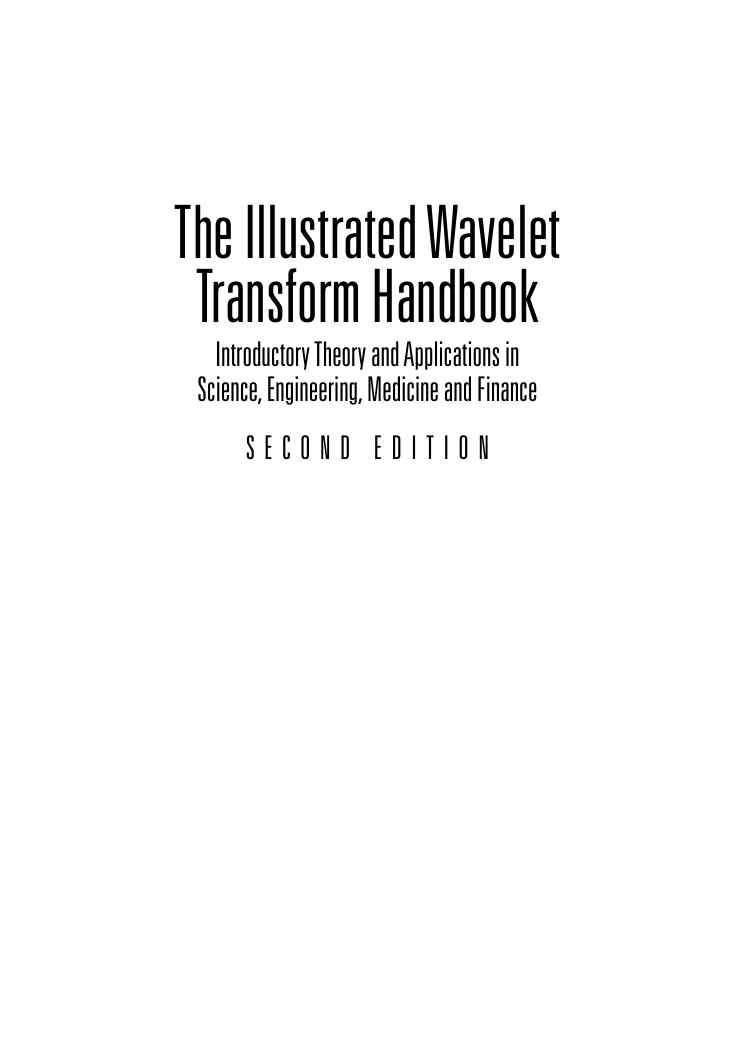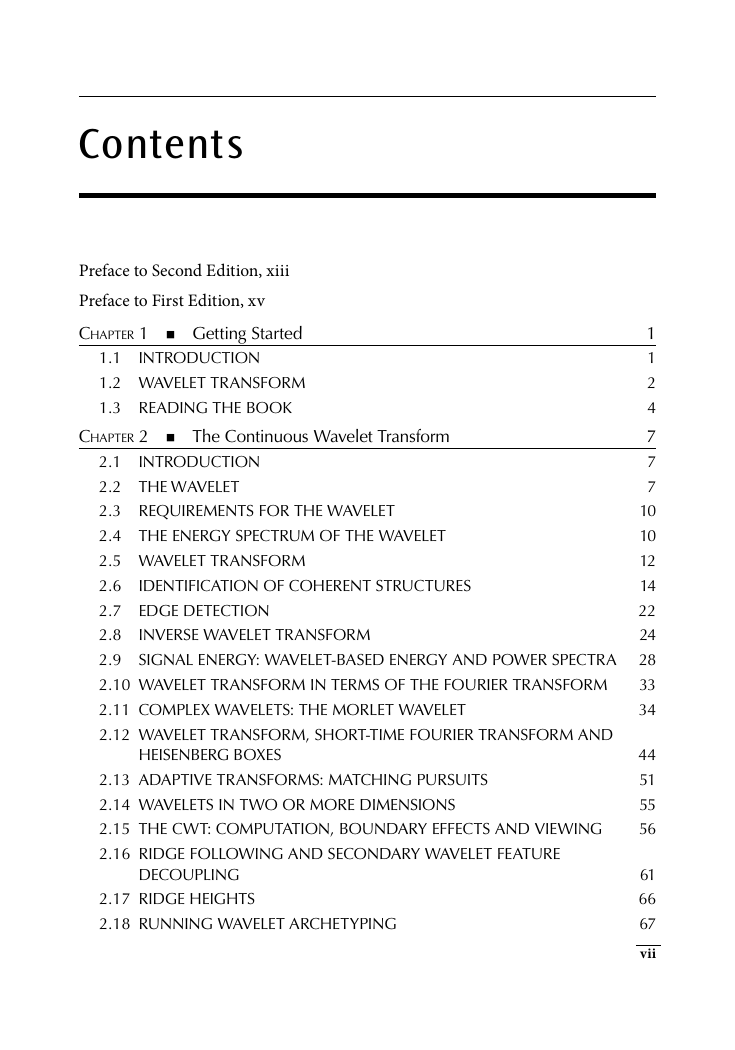Contents
Chapter 1 ▪ Getting Started
1.1 INTRODUCTION
1.2 WAVELET TRANSFORM
1.3 READING THE BOOK
Chapter 2 ▪ The Continuous Wavelet Transform
2.1 INTRODUCTION
2.2 THE WAVELET
2.3 REQUIREMENTS FOR THE WAVELET
2.4 THE ENERGY SPECTRUM OF THE WAVELET
2.5 WAVELET TRANSFORM
2.6 IDENTIFICATION OF COHERENT STRUCTURES
2.7 EDGE DETECTION
2.8 INVERSE WAVELET TRANSFORM
2.9 SIGNAL ENERGY: WAVELET-BASED ENERGY AND POWER SPECTRA
2.10 WAVELET TRANSFORM IN TERMS OF THE FOURIER TRANSFORM
2.11 COMPLEX WAVELETS: THE MORLET WAVELET
2.12 WAVELET TRANSFORM, SHORT-TIME FOURIER TRANSFORM AND HEISENBERG BOXES
2.13 ADAPTIVE TRANSFORMS: MATCHING PURSUITS
2.14 WAVELETS IN TWO OR MORE DIMENSIONS
2.15 THE CWT: COMPUTATION, BOUNDARY EFFECTS AND VIEWING
2.16 RIDGE FOLLOWING AND SECONDARY WAVELET FEATURE DECOUPLING
2.17 RIDGE HEIGHTS
2.18 RUNNING WAVELET ARCHETYPING
2.19 WAVELET TRANSFORM REPHASING
2.20 REASSIGNMENT AND SYNCHROSQUEEZING
2.21 COMPARING TWO SIGNALS USING WAVELET TRANSFORMS
2.21.1 Transform Differences and Ratios
2.21.2 Cross-Wavelet Transform
2.21.3 Wavelet Cross-Correlation
2.21.4 Phase Comparison Measures
2.21.5 Wavelet Coherence
2.22 BICOHERENCE AND CROSS-BICOHERENCE
2.23 ENDNOTES
2.23.1 Chapter Key Words and Phrases
2.23.2 Additional Notes and Resources
2.23.3 Tings to Try
2.23.4 Final Note: Te CWT as a ‘Sof Tool’ for Algorithm Development
Chapter 3 ▪ The Discrete Wavelet Transform
3.1 INTRODUCTION
3.2 FRAMES AND ORTHOGONAL WAVELET BASES
3.2.1 Frames
3.2.2 Dyadic Grid Scaling and Orthonormal Wavelet Transforms
3.2.3 Scaling Function and Multiresolution Representation
3.2.4 Scaling Equation, Scaling Coefcients and Associated Wavelet Equation
3.2.5 Haar Wavelet
3.2.6 Coefcients from Coefcients: Fast Wavelet Transform
3.3 DISCRETE INPUT SIGNALS OF FINITE LENGTH
3.3.1 Approximations and Details
3.3.2 Multiresolution Algorithm: An Example
3.3.3 Wavelet Energy
3.3.4 Alternative Indexing of Dyadic Grid Coefcients
3.3.5 A Simple Worked Example: Te Haar Wavelet Transform
3.4 EVERYTHING DISCRETE
3.4.1 Discrete Experimental Input Signals
3.4.2 Smoothing, Tresholding and Denoising
3.5 DAUBECHIES WAVELETS
3.5.1 Filtering
3.5.2 Symmlets and Coiflets
3.6 TRANSLATION INVARIANCE
3.7 BIORTHOGONAL WAVELETS
3.8 TWO-DIMENSIONAL WAVELET TRANSFORMS
3.9 ADAPTIVE TRANSFORMS: WAVELET PACKETS
3.10 ‘X-LETS’: CONTOURLETS, RIDGELETS, CURVELETS, SHEARLETS AND SO ON
3.11 ENDNOTES
3.11.1 Chapter Key Words and Phrases
3.11.2 Further Resources
Chapter 4 ▪ Fluids
4.1 INTRODUCTION
4.2 STATISTICAL MEASURES FOR FLUID TURBULENCE
4.2.1 Moments, Energy and Power Spectra
4.2.2 Intermittency and Correlation
4.2.3 Wavelet Tresholding
4.2.4 Wavelet Selection Using Entropy Measures
4.3 ENGINEERING FLOWS
4.3.1 Experimental Flows: Jets, Wakes, Turbulence and Coherent Structures
4.3.2 Computational Fluid Dynamics: Simulation and Analysis
4.3.3 Fluid–Structure Interaction
4.4 GEOPHYSICAL FLOWS
4.4.1 Atmospheric Processes: Wind, Boundary Layers and Turbulence
4.4.2 Ocean Processes: Waves, Large-Scale Oscillations, Ocean–Atmosphere Interactions and Biological Processes
4.4.3 Rainfall and River Flows
4.5 TWO-PHASE FLOWS
4.6 OTHER APPLICATIONS IN FLUIDS
Chapter 5 ▪ Engineering Testing, Monitoring and Characterization
5.1 INTRODUCTION
5.2 DYNAMICS
5.2.1 Fundamental Behaviour
5.2.2 Chaos
5.3 NON-DESTRUCTIVE TESTING OF STRUCTURAL ELEMENTS
5.4 CONDITION MONITORING OF ROTATING MACHINERY
5.4.1 Gears
5.4.2 Shafs, Bearings and Blades
5.5 MACHINING PROCESSES
5.6 CHARACTERIZATION OF SURFACES AND FIBROUS MATERIALS
5.7 OTHER APPLICATIONS IN ENGINEERING
5.7.1 Compression
5.7.2 Control
5.7.3 Electrical Systems and Circuits
5.7.4 Miscellaneous
Chapter 6 ▪ Medicine
6.1 INTRODUCTION
6.2 ELECTROCARDIOGRAM
6.2.1 ECG Beat Detection and Timings
6.2.2 Detection of Abnormalities
6.2.3 Heart Rate Variability
6.2.4 Cardiac Arrhythmias
6.2.5 ECG Data Compression
6.2.6 Hardware Implementation
6.3 NEUROELECTRIC WAVEFORMS
6.3.1 Evoked Potentials and Event-Related Potentials
6.3.2 Epileptic Seizures and Epileptogenic Foci
6.3.3 Sleep Studies
6.3.4 Other Areas
6.4 PHOTOPLETHYSMOGRAM
6.4.1 Respiratory Modulations, Respiratory Rate and Respiratory Effort
6.4.2 Oxygen Saturation
6.4.3 Te Video Photoplethysmogram (Video-PPG)
6.4.4 Other Areas
6.5 PATHOLOGICAL SOUNDS, ULTRASOUNDS AND VIBRATIONS
6.5.1 Cardiovascular System
6.5.2 Lung Sounds, Swallowing, Snoring and Speech
6.5.3 Acoustic Response
6.6 BLOOD FLOW AND BLOOD PRESSURE
6.7 MEDICAL IMAGING
6.7.1 Optical Imaging
6.7.2 Ultrasonic Images
6.7.3 Computed Tomography, Magnetic Resonance Imaging and Other Radiographic Images
6.8 OTHER APPLICATIONS IN MEDICINE
6.8.1 Electromyographic Signals
6.8.2 Posture, Gait and Activity
6.8.3 Analysis of Multiple Biosignals
6.8.4 Miscellaneous
Chapter 7 ▪ Fractals, Finance, Geophysics, Astronomy and Other Areas
7.1 INTRODUCTION
7.2 FRACTALS
7.2.1 Exactly Self-Similar Fractals
7.2.2 Stochastic Fractals
7.2.3 Multifractals
7.3 FINANCE
7.4 GEOPHYSICS
7.4.1 Properties of Subsurface Media: Well Logging, Cores and Seismic Methods
7.4.2 Remote Sensing
7.5 ASTRONOMY: SIGNALS AND IMAGES
7.6 OTHER AREAS
REFERENCES,
APPENDIX: USEFUL BOOKS, PAPERS AND WEBSITES,
INDEX,
















 2023年江西萍乡中考道德与法治真题及答案.doc
2023年江西萍乡中考道德与法治真题及答案.doc 2012年重庆南川中考生物真题及答案.doc
2012年重庆南川中考生物真题及答案.doc 2013年江西师范大学地理学综合及文艺理论基础考研真题.doc
2013年江西师范大学地理学综合及文艺理论基础考研真题.doc 2020年四川甘孜小升初语文真题及答案I卷.doc
2020年四川甘孜小升初语文真题及答案I卷.doc 2020年注册岩土工程师专业基础考试真题及答案.doc
2020年注册岩土工程师专业基础考试真题及答案.doc 2023-2024学年福建省厦门市九年级上学期数学月考试题及答案.doc
2023-2024学年福建省厦门市九年级上学期数学月考试题及答案.doc 2021-2022学年辽宁省沈阳市大东区九年级上学期语文期末试题及答案.doc
2021-2022学年辽宁省沈阳市大东区九年级上学期语文期末试题及答案.doc 2022-2023学年北京东城区初三第一学期物理期末试卷及答案.doc
2022-2023学年北京东城区初三第一学期物理期末试卷及答案.doc 2018上半年江西教师资格初中地理学科知识与教学能力真题及答案.doc
2018上半年江西教师资格初中地理学科知识与教学能力真题及答案.doc 2012年河北国家公务员申论考试真题及答案-省级.doc
2012年河北国家公务员申论考试真题及答案-省级.doc 2020-2021学年江苏省扬州市江都区邵樊片九年级上学期数学第一次质量检测试题及答案.doc
2020-2021学年江苏省扬州市江都区邵樊片九年级上学期数学第一次质量检测试题及答案.doc 2022下半年黑龙江教师资格证中学综合素质真题及答案.doc
2022下半年黑龙江教师资格证中学综合素质真题及答案.doc